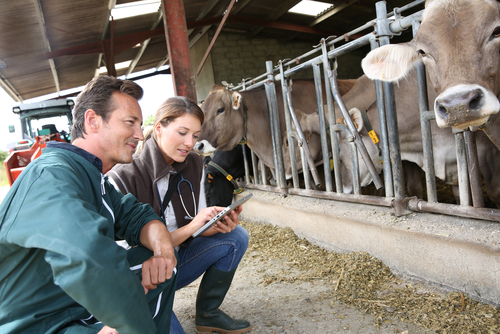



How to Use Activity Monitors to Get Her in Calf
Estrus detection is growing in popularity, particularly on MidWest farms, but with the benefits of higher insemination rates and labour savings, fine tuning is required.Pedometers and activity monitors need work for optimum heat detection accuracy, write Gabriel Bombardelli, Henrique Soares, and Ricardo Chebel Department of Veterinary Population Medicine, University of Minnesota.
Figure 1. Expected probability of P/AI of lactating Jersey cows inseminated with sex-sorted semen according to interval from onset of estrus (activity monitors) to AI. *Represents expected timing of ovulation.
*
"More recently, it has been suggested that the ideal interval from increased activity to AI for maximum P/AI was 4 to 12 hours in mature cows and approximately 16 hours for heifers."
The use of such systems presents opportunities to increase the percentage of the herd inseminated in estrus (heat) and reduce the use of reproductive hormones.
In large herds, the use of such systems may also reduce labour necessary for heat detection (e.g. visual or tail paint).
Conventional Semen and Ideal Time of AI
Using a mounting detecting device, researchers determined that P/AI was greatest when the interval from first mount (onset of estrus) to AI was 4 to 12 hours.
More recently, it has been suggested that the ideal interval from increased activity (above a minimum threshold) to AI for maximum P/AI was 4 to 12 hours in mature cows and approximately 16 hours for heifers. These findings have a physiological explanation.
Ovulation occurs approximately 28 to 30 hours after a cow starts to demonstrate signs of estrus (e.g. first mount, increased activity).
After ovulation, a viable egg is present in the uterus of the cow for approximately 10 hours.

Following AI, the sperm cells are viable in the uterus for approximately 24 hours and within this period (first 10 hours) the sperm cells undergo chemical reactions to allow fertilization.
Therefore, insemination of cows 4 to 16 hours after onset of estrous would represent insemination approximately 12 to 26 hours before ovulation.
Inseminating cows too early (< 4 hours after the onset of estrus) may reduce P/AI because of limited number of viable sperm cells to fertilize the egg and inseminating cows too late (> 16 hours after onset of estrus) may reduce P/AI because by the time sperm cells are ready for fertilization there would be no viable egg to be fertilized.
Sex-sorted Semen and Ideal Time of AI
Sex-sorted semen is produced from ejaculates that are processed (stained and separated) to result in semen with sperm cells predominantly containing X (female) or Y (male) chromosomes.
Although the sex-sorting process results in high 'purity' (90 to 95 per cent of all sperm cells in a straw of semen are of the desired sex), the production of sex-sorted semen is 'costly' because a large portion of the ejaculate is 'lost' in the process.
Therefore, straws of sex-sorted semen often have 10 times fewer sperm cells (2 x 106 cells/straw) than conventional semen (20 x 106 cells/straw). The processing of the ejaculate to obtain sex-sorted semen and the reduced number of sperm cells in straws of sex-sorted semen often are blamed for the reduced P/AI observed with the use of sex-sorted semen.
Considering the reduced number of sperm cells in a straw of sex-sorted semen and the apparent reduced viability of sperm cells from sex-sorted semen, strategies have been evaluated to improve P/AI following insemination with sex-sorted semen.
Of particular interest is the timing of AI in relation to the onset of estrus. Insemination with sex-sorted semen 4 to 16 hours after onset of estrus (recommended for conventional semen) may limit the number of sperm cells available for fertilization when an egg is ready to be fertilized.
Actually, researchers demonstrated that P/AI of Jersey heifers inseminated with sex-sorted semen was greatest when AI occurred approximately 16 to 24 hours after the onset of estrus (12 to 16 hours = 37.7 per cent, 16.1 to 20 hours = 51.8 per cent, 20.1 to 24 hours = 55.6 per cent, 24.1 to 30 hours = 45.5 per cent).
Our research group is currently conducting a large experiment with lactating Jersey cows (n = 600) to determine the ideal time of AI with sex-sorted semen in relation to the onset of estrus, based on increased activity.
Preliminary data are promising and suggest that lactating cows receiving sex-sorted semen should be inseminated between 20 and 28 hours after onset of estrus to achieve optimum P/AI (Figure 1).
Experiments that explore the best alternatives to increase P/AI of heifer and particularly lactating cows following insemination with sex-sorted semen are crucial to allow dairy producers to make the best possible use of such technology without compromising reproductive parameters.
References1. Dransfield MB, Nebel RL, Pearson RE, Warnick LD. 1998. Timing of insemination for dairy cows identified in estrus by a radiotelemetric estrus detection system. J Dairy Sci. 81:1874-82.2. Stevenson JS, Hill SL, Nebel RL, DeJarnette JM. 2014. Ovulation timing and conception risk after automated activity monitoring in lactating dairy cows. J Dairy Sci. 97:4296-308.3. Valenza A, Giordano JO, Lopes G Jr, Vincenti L, Amundson MC, Fricke PM. 2012. Assessment of an accelerometer system for detection of estrus and treatment with gonadotropin-releasing hormone at the time of insemination in lactating dairy cows. J Dairy Sci. 95:7115-27.4. Sá Filho MF, Ayres H, Ferreira RM, Nichi M, Fosado M, Campos Filho EP, Baruselli PS. 2010. Strategies to improve pregnancy per insemination using sex-sorted semen in dairy heifers detected in estrus. Theriogenology 74:1636-42.



